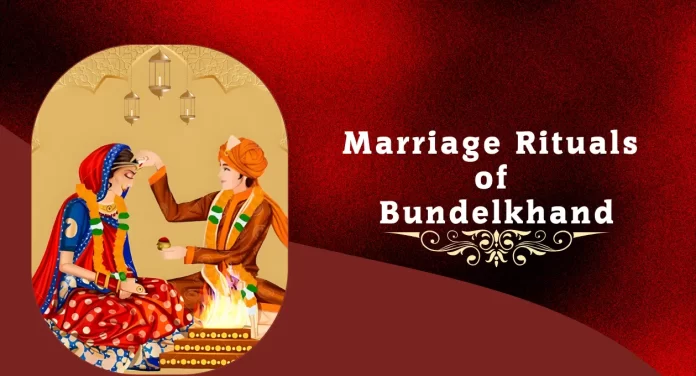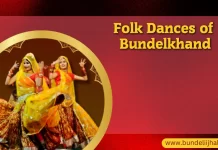Marriage Rituals of Bundelkhand based on Sanatan Sanskriti.
In Sanatan Dharma, marriage is considered as an essential ‘Sanskar’ of life. The meaning of marriage is to fulfill the responsibility. There is a relationship of many births between husband and wife. Which cannot be broken under any circumstances. Some traditional customs, rituals and religious rites are different in Bundeli marriage
Bundeli Marriage Rites
Engagement
In Bundelkhand, the practice of engagement is still going on according to the ancient tradition. There has been a slight change with time. But even today, the relationship of a boy and a girl is confirmed by giving some money and fruits, sweets in front of the Panch, Mukhiya, elders of the house.
Godh Bharai
After the engagement, the boy’s father fills the girl’s lap. In this tradition, a gold or silver ornament is worn and fruits, sweets, coconut are put in her lap. The Pandit fixes the time of marriage and gets the Lagna Patrika written. In which the dates of mother worship, oil, mandap, door-step, teeka and Bhawar are written.
The Pandit makes a statue of Ganesha from cow dung and fills the ground with a square and installs Ganesha and then worships the Lagna Patrika. After that all the relatives touch the Lagna Patrika with their hands. And then that Patrika is sent to the Samadhi’s house by the barber.
After the engagement is confirmed, the barber reaches the Samadhi’s house with the Lagna Patrika. In the evening, close relatives and Panch come. The Pandit reads the Lagna Patrika. Laddus and batases are distributed as a treat. And everyone eats. This is called Lagna ki Pangat. And with this the marriage ceremony begins in both the bride and the bride’s house.
In the marriage ceremony, the program of mother worship, oil, mandap etc. is carried out in the houses of both the bride and the groom according to the auspicious time. Oil is offered by both the parties. Five times to the bride and seven times to the groom. After the oil, the mandap is buried. Which is buried by the respectable people of both the parties (brother-in-law and uncle).
Matri Pujan
After oil, Mayno (Matri Pujan) takes place. In this, women worship the mine and bring soil. A stove is made with this soil. On which first of all Mehar (which is offered to the family deity) is baked. In Mehar, jaggery is mixed with wheat flour and it is kneaded and small balls and in some places wicks are made and then rolled. These are called Mayen (Maai).
Mandap
The mandap is mostly made of wood of the palash tree. It is made by the carpenter. When the carpenter brings the mandap, it is worshipped. And the carpenter is given grains and money as a token of good luck. Later, the ground is worshipped and a pit is dug. Money and five turmeric knots are put in the pit and five people hold the mandap and install it. Then after performing the fire, food from the kitchen is offered. The mandap is worshipped with the sentiment of Brahma. Just as Brahma has four faces, similarly the mandap has four faces. Folk songs are sung while digging the mandap.
The carpenter has brought a well-crafted mandap made of sandalwood. Uncle has worshipped it and installed it. And has covered it with mango and jamun leaves. Aunt has brought water in a golden pot and fifty-six food items. With which food has been offered in the mandap. All the relatives of the family have started singing Mangal Gaan while remembering the Kul Devta. After Mandap Poojan, Kadhi, Chana Dal, Bhaat, Bara are prepared. This row is called Mandap Ki Pangat.
Cheekat (Bhaat)
After Mandap, the gift given by the brother to the sister whose son or daughter is getting married is called Cheekat (it is also called Bhaat Dena). The brother presents it by keeping a cloth on his back. Later the sister makes the brother sit under the Mandap and feeds him sweets. After Cheekat, all the family members invite the Gods and Goddesses at night.
Tika (Dwarchar)
In Bundelkhand, the groom’s tika is mostly done on a horse. At some places it is also done on a palanquin or a pata.
Preeti Bhoj
After Tika (Dwarchar), there is a feast. Which is called Agouni Ki Pangat. In this, puri, vegetable, sweets, raita etc. are served. During the pangat, women sing folk songs which are called gari.
Chadhava
After pangat (community meal), the boy’s father goes to offer offerings to the bride. And in the middle of the mandap, the father-in-law himself gives gold and silver ornaments to the girl with his own hands. And puts coconut and batasa in her oli. He worships the girl considering her to be a form of Shakti.
After offering the offering, during the parikrama (circumambulation), seven sages and seven seas are established. In this, fourteen vessels of some metal or clay are kept. Which are considered to be the form of the seven sages and seven seas. When the bride and the groom sit at their respective places under the mandap. Then the Pandit performs havan by offering “Shakily” made of Jawa, sesame, sugar, honey, ghee with the chanting of mantras.
Kanyadan
After the havan, the father of the girl places his daughter’s hand in the groom’s hand and performs the kanyadan (marriage). The pandit recites the mantra of kanyadan sankalp. Cow donation is also done on this occasion.
Bhavar (Parikrama)
The pandit makes the bride and groom take a vow. The groom takes seven vows to always accept the bride. And the bride takes five vows to always accept the groom. When the groom and the bride take a vow, then the bhavar (parikrama) starts. Women sing songs while the bhavar takes place.
Paanv Pakhrai
After Parikrama, Paanv Pakhrai is done. While washing the feet of the bride and groom, money, jewellery and other things are given as gifts. After this, the groom enters the manhar-griha (family deity house) of his father-in-law. Then his sister-in-laws put a curtain on the door and stop him from entering. And sing songs……….
After entering the groom’s house, a flame is lit in front of the family deity. In which the bride and groom unite the two burning wicks with their hands and prove that their two hearts are united. In this flame, the groom is given a gift. After this, Dooda-Bhaati (bride and groom feed each other with milk and rice). In this too, the feeling of two hearts becoming one is shown. After this, the groom goes to his wife’s house.
Kunar Kaleu
The groom then comes to his father-in-law’s house for Kunar Kaleu. And he does Kaleu only after being persuaded. At this time, the groom is also given gifts according to his wish.
Vidaai
After the marriage ceremony is over, only Vidaai and dowry collection remain. For this, the groom comes to the middle of the Mandap with his wife. The groom leaves the Kankan of the Mandap and bids farewell to his father-in-law and mother-in-law.
Reference-
बुंदेली लोक साहित्य परंपरा और इतिहास – डॉ. नर्मदा प्रसाद गुप्त
बुंदेली लोक संस्कृति और साहित्य – डॉ. नर्मदा प्रसाद गुप्त
बुन्देलखंड की संस्कृति और साहित्य – श्री राम चरण हयारण “मित्र”
बुन्देलखंड दर्शन – मोतीलाल त्रिपाठी “अशांत”
बुंदेली लोक काव्य – डॉ. बलभद्र तिवारी
बुंदेली काव्य परंपरा – डॉ. बलभद्र तिवारी
बुन्देली का भाषाशास्त्रीय अध्ययन -रामेश्वर प्रसाद अग्रवाल




